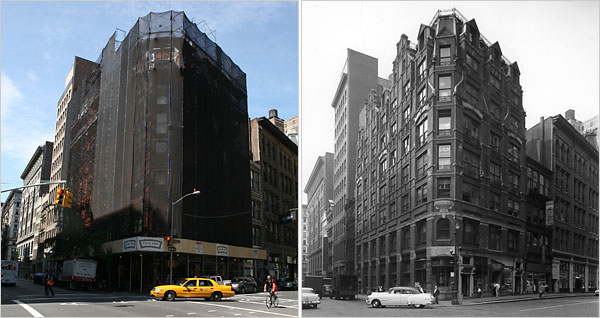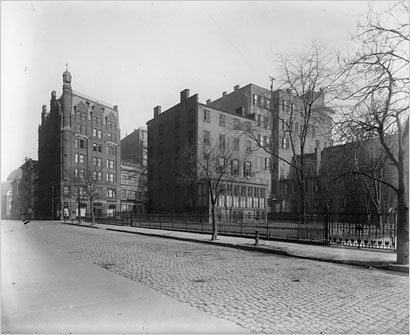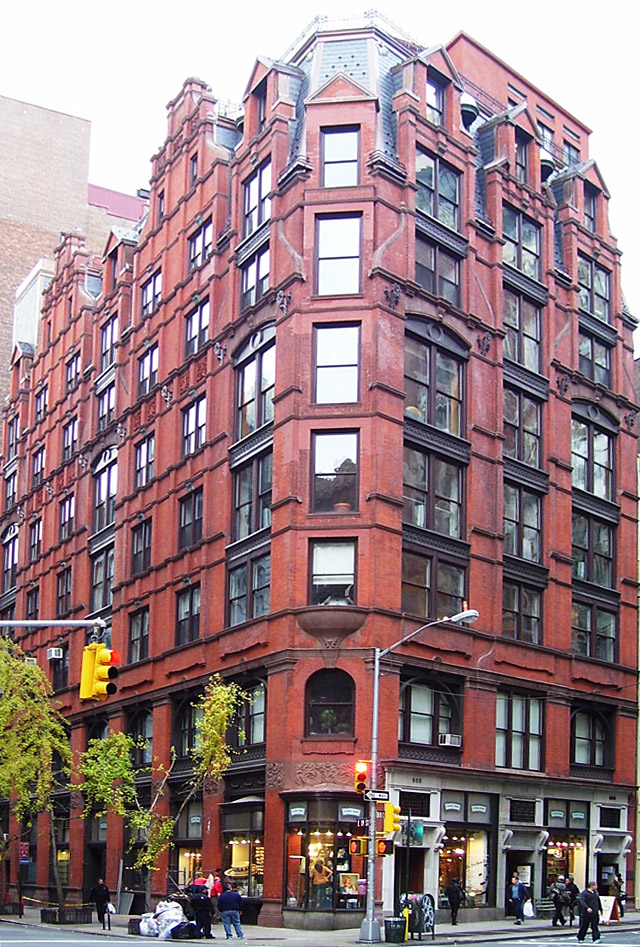quote:
A Silver-Footed Residence for Gentlemen
The 1884 Gorham Building, at Broadway & 19th St.]
By Christopher Gray
New York Times
Real Estate Section
Streetscapes
September 3, 2009 
Left, Chester Higgins Jr./The New York Times; Office for Metropolitan HistoryThe 1884 Gorham Building at Broadway and 19th Street, today, wreathed in protective netting, and in 1955.

New-York Historical SocietyThe Gorham, with its minaret, is pictured about 1890. In the foreground is the backyard of Peter Goelet, an eccentric tycoon who owned the land that the store was built upon.
IT has temporarily disappeared under protective renovation netting, but in the 1880s, you would have found the Gorham Silver Company between Tiffany & Company and Brooks Brothers. Located on Broadway at 19th Street, it was almost equidistant between the jeweler, at 15th Street, and the men’s store, at 22nd.
The stretch was in its shopping prime. But unlike its cohort of high-end retailers, the 1884 Gorham Building also served as an apartment house, an unusual mixed use.
The land for the store was leased from the Goelets, an old merchant family that owned much of the property along Broadway north of Union Square. The area perked up in the 1860s, when Tiffany began work on its large cast-iron store at 15th Street, along the west side of Union Square.
Peter Goelet lived in a blocky brick mansion at the northeast corner of 19th, and Gorham built opposite his house. The family probably had a hand in the project, since the new store was by its favored architect, Edward H. Kendall. He designed the silversmith’s building in the Queen Anne style, a recent creation by the English architect Richard Norman Shaw; it had almost nothing to do with the 18th-century English sovereign.
The eight-story structure was close in character to the big London apartment houses of the 1880s, a complicated red brick facade with bays of multipaned windows and a corner tower. Its picturesque roof line of gables and peaks and mansards ranged across the sky like an urban Bryce Canyon, with a pig’s-tail curlicue in the iron cresting at the top. The tower had tiny oval windows, and ended in a minaret; Mr. Kendall was aiming for a charm completely lacking in the older palazzo-style store buildings.
When Gorham opened in the spring of 1884, The New York Times called it “the most extensive silverware house in this country,” and a year later described the glittering scarf pins, sleeve buttons, punch bowls, fob chains, hat brushes, buttonhooks, flatware and other goods as “ruinous to weak eyes."
But Gorham occupied only the first and second floors. The third through eighth were laid out as “apartments for gentlemen,” as an ad in The Times put it. Each had a bedroom and a parlor and was without a kitchen; it was assumed that a gentleman could take his meals at his club.
The architect Joseph Pell Lombardi, who renovated the Gorham building into loft apartments in 1977, has copies of the original plans. They show the parlor as a corner room about 16 by 20 feet, with a fireplace and flues running up the tower — the minaret was a chimney.
Queen Anne sprang up in New York 1878 like a summer squall, but by 1884, Mr. Kendall was riding the tail end. A year earlier, The Real Estate Record and Guide had remarked that “we are having too much of the Queen Anne” and in 1887 twisted the knife with the offhand remark that “it tells of a passing fashion, of which the architect, no doubt, is as tired as anybody else.”
As the critic Paul Goldberger has noted, the opinions of architectural writers are little heard in the marketplace, and the 1893 King’s Handbook of New York City described the store approvingly as “a perpetual exhibition of American art.”
Likewise, the bachelors upstairs seem to have been unperturbed. They were mostly bankers, lawyers and businessmen like Charles Peet, a founder of Rogers Peet, the men’s clothing store.
Within two decades, however, signs were clear that the shining moment of these few blocks would be brief. The carriage trade was moving on, and Tiffany, Brooks Brothers and others soon left for the 30s and 40s.
In 1905 Gorham, too, migrated, up to 36th and Fifth Avenue, and commercial tenants took over the old retail structures. A photograph from the 1950s shows signs on the Gorham building for Galdi Imports, Thrifty Sales and a toy wholesaler on the ground floor.
By that time the complicated fenestration had given way to plain windows, and the corner tower had been removed; the part-oval ledge at the third floor is the only trace.
Mr. Lombardi says that when he arrived, the apartment interiors had already been swept away. Then, residential conversions of a commercial building were just getting off the ground, and Mr. Lombardi said that “very few knew the word ‘loft’ as a residence — it was a brand-new term.”
Now the co-ops upstairs in the Gorham building coexist with the ground-floor jumble of Fishs Eddy, a vintagey crockery place where the tubs and crates of dishes and bowls are a far cry from Gorham’s cool mahogany cases of glittering silver and gold.
Today, all that remains of Brooks Brothers are its fluted spiral columns, peeking out from behind a modernization of the 1980s. The Tiffany building survives as an iron framework under a glistening new apartment house.
Even altered, Gorham has outlasted them both.

 SMP Silver Salon Forums
SMP Silver Salon Forums

 American Sterling Silver
American Sterling Silver

 The 1884 Gorham Building, at Broadway & 19th St.
The 1884 Gorham Building, at Broadway & 19th St.











